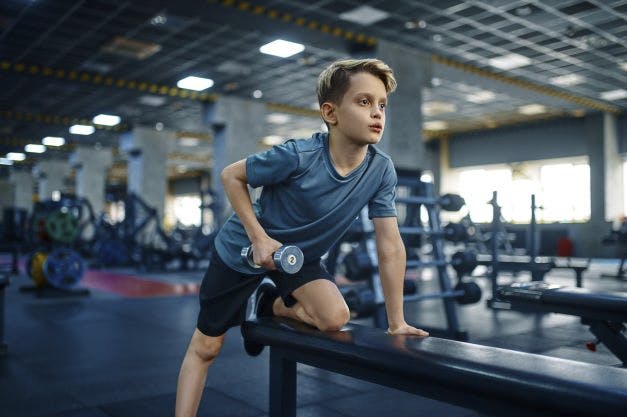Growth plate injuries occur when young athletes perform repetitive activities at high intensities, frequencies, or both. These injuries are becoming increasingly common because children are being pushed to play competitive sports year-round without breaks. Overuse injuries involving the growth plates are concerning because of the potential to disturb growth. This article discusses how parents and coaches can recognize, prevent, and treat growth plate injuries.
What are Growth Plate Injuries?
The growth plate is located at each end of long bones like the upper arm and shin bone. This area of bone provides for growth in length. The growth plate is made of cartilage and is the last portion of the growing bone to form solid bone.

In children, the growth plate is 2 to 5 times weaker than other structures like ligaments and tendons. Therefore, it is more likely to be injured in physically immature athletes. Later maturing children may experience a lengthened time at risk of growth plate injuries because their period of growth is prolonged.
Physical activity is necessary to support normal bone growth. However, increases in load over time, beyond the body’s ability to adapt, may cause injury. Overuse may cause injury to the blood supply around the growth plate. As a result, bone cells continue to increase in number and size but are not able to turn into mature bone. This causes a widening of the growth plate which can be seen on X-rays.
Who is At Risk for Growth Plate Injuries?
The growth plates most at risk for a stress-related injury are the ones most loaded during repetitive activity. For example, a gymnast may repetitively bear weight on the wrist bone while performing floor routines and vaulting. A young baseball player may repetitively stress the shoulder and elbow while pitching during a long season. This contributes to Little League Shoulder or Little League Elbow.

Children who participate in sports at advanced levels of training and competition are at an increased risk of growth plate injuries. Early sport specialization and over-training contribute to increased risk. It is extremely important that parents encourage young athletes to play multiple sports and not specialize before physical maturity.
It is also important to recognize that non-elite young athletes are not spared from growth plate injuries. This is because the risk among all young athletes is increased during periods of rapid growth. For most girls, this is between the ages of 11 and 13. For most boys, rapid growth occurs between the ages of 12 and 14. During these ages, parents must be especially cautious to avoid pushing athletes into too much training and competition.
Reducing the Risk for Growth Plate Injuries?
Training and skill development should always be individualized. In particular, coaches should reduce repetitive training loads and delay skill progressions for young athletes experiencing periods of rapid growth. Coaches should use a variety of drills during practice to avoid excessive repetitive movements that may result in a stress-related injury. Emphasis should always be on the quality of workouts rather than training volume.

Sampling multiple sports allows the body to recover, adapt, and become more resilient to repetitive stress. For those athletes who compete and train in a single sport year-round, a properly designed and supervised strength and conditioning program is needed. An age-appropriate program allows the athlete to explore a diversity of movement patterns and build strength in order to reduce injury risk.
Recognizing Growth Plate Injuries
Growth plate injuries must always be considered when young athletes experience ongoing pain during sports activities, especially in adolescents experiencing rapid growth. Most athletes tend to not recall a specific event that caused their pain. Instead, the pain develops gradually.
Common symptoms include:
- Pain and tenderness at the end of a bone or near a joint
- Swelling
- Limited joint motion
- Sharp pain within the first few minutes of participation in their sport
If you suspect your child may have a growth plate injury, it is important to seek care from a medical professional. An athletic trainer, physical therapist, or sports medicine doctor is your best option. If proper care is sought early and not delayed, these injuries tend to respond well.
Proper Treatment of Growth Plate Injuries
Growth plate injuries usually resolve with rest and do not produce growth disturbances. However, without proper treatment, the injury may lead to a deformity or growth disruption.

Growth plate injuries are treated differently depending on the severity and location of the injury. In most cases, the young athlete will need to rest the area of injury and perform physical therapy to address any underlying factors contributing to the injury. Rehabilitation includes exercises to improve strength and make the athlete more resilient to future problems.

In severe cases, the area of injury may need to be casted or splinted to allow healing. Regardless of the exact treatment, the athlete will need to meet functional testing criteria prior to being cleared to return to sport. A gradual return to sport protocol should be managed by the athlete’s physical therapist before full clearance is given. This may take a few weeks or several months.
See Your Physical Therapist to Get Back to Sports
The saying, “too much too soon” applies to young athletes and the potential for growth plate injuries. Parents and coaches should encourage well-rounded athletes who play multiple sports throughout the course of the year. Chasing medals, trophies, and championships at early ages usually leads to overuse, burnout, and injury.
If your child or athlete is suffering from a repetitive sports injury, get help from your doctor or physical therapist. The physical therapists at BSR have been helping young athletes in Southern Ocean County move without pain since 2007. Get help by calling to schedule an initial evaluation with one of our Doctors of Physical Therapy.

